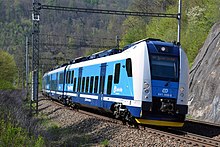-
Railways in the Czech Republic
-
Electrified main lines in the Czech Republic
-
1883 railway map of Kingdom of Bohemia
-
1899 railway map of Western Central Europe

Summary
Rail transport in the Czech Republic carried 193.5 million passengers in 2019,[2] and 68.37 million tonnes of cargo in the year 2009.[3] The majority of passenger services run nowadays are operated by the state company České dráhy (Czech Railways), which until 2007 also managed cargo services now run by ČD Cargo. In 2009 the country had 9,420 km of standard gauge track, 3,153 km of which is electrified.[3] There are two main electrification systems in the Czech Republic, 3 kV DC in the northern part, and 25 kV 50 Hz AC in the south (in addition, one historical 24 km long line uses 1.5 kV DC; and since 2009 one short local line to Austria uses 15 kV 16.7 Hz AC). Locomotives had to be changed on boundaries in the past, two-system locomotives have been introduced in 1974. The network has same gauge links to all four countries bordering the Czech Republic (Slovakia, Austria, Germany and Poland) with passenger services to all four countries in operation. Major hubs for international passenger services on the network are in Prague, Ostrava, Brno and Břeclav,[4] and the busiest station (by number of passengers) is Praha hlavní nádraží. Maximum speed on Czech rails is 160 km/h (99mph).
| Czech Republic | |||||
|---|---|---|---|---|---|
 | |||||
| Operation | |||||
| National railway | České dráhy | ||||
| Infrastructure company | Správa železnic | ||||
| Major operators |
| ||||
| System length | |||||
| Total | 9,619 kilometres (5,977 mi) | ||||
| Double track | 1,830 kilometres (1,140 mi) | ||||
| Electrified | 2,997 kilometres (1,862 mi) | ||||
| High-speed | 0 kilometres (0 mi) | ||||
| Track gauge | |||||
| Main | 1,435 mm (4 ft 8+1⁄2 in) | ||||
| Features | |||||
| No. tunnels | 155 | ||||
| Tunnel length | 46.52 kilometres (28.91 mi) | ||||
| Longest tunnel | Ejpovice Tunnel 4,150 metres (13,620 ft) | ||||
| Longest bridge | Negrelliho viadukt 1,110 metres (3,640 ft) | ||||
| No. stations | 2808 | ||||
| Highest elevation | Kubova Huť[1] 995 metres (3,264 ft) | ||||
| Operating speed | 160 km/h (99 mph) | ||||
| |||||
History edit
The history of rail transport in the territory of the present-day Czech Republic dates back to the Austro-Hungarian empire. The first horse-drawn railway in Europe, between České Budějovice and Linz (in present-day Austria) commenced operations in 1832,[5] and the first locomotive-hauled railway from Vienna to Břeclav opened seven years later. Throughout the rest of the 19th century the rail network in the whole of Europe grew rapidly and after the First World War and the independence of Czechoslovakia, the company Československé státní dráhy (Czechoslovak state railways) was founded. From 1948 until the Velvet Revolution the border crossings with Austria and West Germany were strictly controlled and only a limited number of trains was operated. Following the fall of communism, the railway network was reopened to Western Europe; the first EuroCity trains operated in transitional Czechoslovakia in 1991. In the 21st century the network has undergone extensive modernisations, and newer rolling stock (such as the Class 680 "pendolino") have been introduced.
Operation edit
Most of the Czech railway network is maintained by Správa železnic, a state-owned company. In 2010, the Czech government proposed merging Správa železnic (then-called SŽDC) and České dráhy to a single company. In 2011, RegioJet, a subsidiary of Student Agency, became the first company to actively compete with České dráhy on a route, launching a service between Prague and Havířov.[6] Other private companies own exclusive rights to run services on certain lines.[7] The Czech Republic is a member of the International Union of Railways (UIC) and has the country code 54.
Rail links to adjacent countries edit
- Austria – voltage change 25 kV 50 Hz AC to 15 kV 16.7 Hz AC
- Germany – voltage change 3 kV DC to 15 kV 16.7 Hz AC
- Poland – same voltage 3 kV DC
- Slovakia – same voltage 3 kV DC (north) and 25 kV 50 Hz AC (south)
Several border crossings did not survive political changes in 1918 or 1945. However, some of them were renewed after 1989. Border crossings with regular passenger traffic as of 2023: Germany – 11 Austria – 4 Slovakia – 5 Poland – 8
Modern and historical railway maps edit
Gallery edit
See also edit
References edit
- ^ "Prachatice okres, Czech Republic". www.crwflags.com.
- ^ "Railway passenger transport statistics" (PDF). Europa EU. 8 December 2019. Retrieved 9 January 2021.
- ^ a b České dráhy Group, Statistical Yearbook 2009, available online on http://www.cd.cz
- ^ Komarek, Jan. "Cross-city line will transform Praha". Railway Gazette International. Retrieved 13 June 2012.
- ^ Ellington, Lucien (2004). Eastern Europe: An Introduction to the People, Land, and Culture. ABC-CLIO. p. 267. ISBN 1576078000. Retrieved 30 July 2014.
- ^ "České koleje zežloutly. Jančurův vlak poprvé vyjel". iDNES.cz. August 25, 2011.
- ^ "Business | Technology | Automotive trends – railwaymarket.eu". railwaymarket.eu.
Further reading edit
- Fender, Keith (2022). Czech and Slovak Railways: Three Decades of Change, 1990–2020s. World Railways Series, Vol 2. Stamford, Lincs, UK: Key Publishing. ISBN 9781802820294.
External links edit
- Winchester, Clarence, ed. (1936), "In central Europe", Railway Wonders of the World, pp. 1454–1463 illustrated description of the railways of Czechoslovakia in the 1930s.



